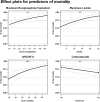Survival after shock requiring high-dose vasopressor therapy
- PMID: 22911566
- PMCID: PMC3590882
- DOI: 10.1378/chest.12-1106
Survival after shock requiring high-dose vasopressor therapy
Abstract
Background: Some patients with hypotensive shock do not respond to usual doses of vasopressor therapy. Very little is known about outcomes after high-dose vasopressor therapy (HDV). We sought to characterize survival among patients with shock requiring HDV. We also evaluated the possible utility of stress-dose corticosteroid therapy in these patients.
Methods: We conducted a retrospective study of patients with shock requiring HDV in the ICUs of five hospitals from 2005 through 2010. We defined HDV as receipt at any point of ≥ 1 μg/kg/min of norepinephrine equivalent (calculated by summing norepinephrine-equivalent infusion rates of all vasopressors). We report survival 90 days after hospital admission. We evaluated receipt of stress-dose corticosteroids, cause of shock, receipt of CPR, and withdrawal or withholding of life support therapy.
Results: We identified 443 patients meeting inclusion criteria. Seventy-six (17%) survived. Survival was similar (20%) among the 241 patients with septic shock. Among the 367 nonsurvivors, 254 (69%) experienced withholding/withdrawal of care, and 115 (31%) underwent CPR. Stress-dose corticosteroid therapy was associated with increased survival (P = .01).
Conclusions: One in six patients with shock survived to 90 days after HDV. The majority of nonsurvivors died after withdrawal or withholding of life support therapy. A minority of patients underwent CPR. Additionally, stress-dose corticosteroid therapy appears reasonable in patients with shock requiring HDV.
Figures


References
-
- Guyton AC, Hall JE. Textbook of Medical Physiology. Philadelphia, PA: Elsevier Saunders;2006
-
- Müllner M, Urbanek B, Havel C, Losert H, Waechter F, Gamper G. Vasopressors for shock. Cochrane Database Syst Rev. 2004; (3):CD003709. - PubMed
-
- Jenkins CR, Gomersall CD, Leung P, Joynt GM. Outcome of patients receiving high dose vasopressor therapy: a retrospective cohort study. Anaesth Intensive Care. 2009;37(2):286-289 - PubMed
-
- Katsaragakis S, Kapralou A, Theodorou D, et al. Refractory septic shock: efficacy and safety of very high doses of norepinephrine. Methods Find Exp Clin Pharmacol. 2006;28(5):307-313 - PubMed
-
- Abid O, Akça S, Haji-Michael P, Vincent JL. Strong vasopressor support may be futile in the intensive care unit patient with multiple organ failure. Crit Care Med. 2000;28(4):947-949 - PubMed
Publication types
MeSH terms
Substances
Grants and funding
LinkOut - more resources
Full Text Sources
Other Literature Sources
Medical

